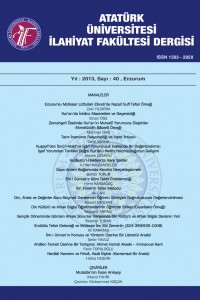Abstract
Some Considerations on Esoteric Interpretation of the Qur’an from Qushairi to Ibn Arabi: The Development of Qur’anic Exegesis from Esoterism to DeterminismInitially, indication (isharat) as not being of serious consideration was a general name of secondary interpretations. In time, this approach has protected sufi knowledge from any dispute and quarrels. The ultimate objective of Sufis when using the term isharat was two: First, they aimed to demonstrate their obedience to the perspectives of Sunni jurists and theologians. Beside of this, they just expressed their views on ethics and purification of nafs in reference to Islamic texts. In this respect, esoteric exegesis referred to the efforts of these sufis in finding out Islamic moral values in connection with the texts using analogy as their ultimate method. Secondly, they intentionally wanted to escape from the difficulties of demonstration. Thus, isharat kept sufis out of any discussion and gave them the opportunity to talk to the one who is qualified enough in the field of tasawwuf (ahl). However this term as being one of the demonstrations of the periodic developments of tasawwuf has gradually gained an extent meaning which is determination (tahqiq). In a proper sense, the term isharat has been progressively replaced by tahqiq. If we try to explain this with the relation between asl (fundament) and far’ (branch), initially the term isharat was a far’ (branch) of the commentaries of Muslim jurists and theologians which was regarded then as asl (fundament). Yet, by Ibn Arabi this term has begun to be considered as asl while the interpretation of Sunni scholars regarded as far’. In this respect, it must be said here that the term isharat not only gives us the commentaries of the Sufis in reference to the Islamic texts it also gives us the clear expression about the formative period of tasawwuf among other Islamic disciplines.
Keywords
The Qur’an Prophetic Tradition Religious Texts Exegesis Indication shatahat tasawwuf Qushairi Ibn Arabi Determination Metaphysics
References
- Ateş, Süleyman, İşari Tefsir Okulu, Yeni Ufuklar Neşriyat, İstanbul, 1998.
- Demirli, Ekrem, Sadreddin Konevi’de Bilgi ve Varlık, İz Yay., İstanbul, 2005.
- _____________İslam Metafiziğinde Tanrı ve İnsan, Kabalcı Yay.,İstanbul, 2011.
- İbnü’l-Arabi, Muhyiddin, Fusûsu’l-Hikem, (çeviri ve şerh: Ekrem Demirli), Kabalcı Yay. İstanbul, 2006. ___________________Fütuhat-ı Mekkiyye, (çev. Ekrem Demirli), Litera Yay.,, İstanbul, 2006-2012, I-XVIII. Kelâbâzî, et-Taarruf: Doğuş Devrinde Tasavvuf, (çev. Süleyman Uludağ), Dergâh Yay., İstanbul, 1992. Konevî, Sadreddin, İ‘câzü’l-beyân fî te’vîli’l-ümmi’l-Kur’ân: Fatiha Suresi Tefsiri, (çev. Ekrem Demirli) İz Yay., İstanbul, 2002. Kuşeyrî, Abdülkerîm, Kuşeyrî Risâlesi: Tasavvuf İlmine Dâir, (çev. Süleyman Uludağ), Dergâh Yay., 3.bsk., İstanbul, 1999. _________________,Letaifü’l-işârât, (thk. İbrâhim Besyuni), el-Hey’etü’lMısriyyetü’l-Âmme li’l-Kitâb, 2. Bsk., Kāhire, 1981, I-II. _________________,Nahvu’l-Kulûb, (Tahkik ve şerh: İbrahim Besyuni-Ahmed Alemüddin el-Cendi), Mektebetü’l-Âlemi’l-Fikr, Kāhire, 1994. Tirmizî, Hakîm, Beyânü’l-fark beyne’s-sadri ve’l-kalbi ve’l-fuâdi ve’l-lübbi: Kalbin Anlamı, (çev. Ekrem Demirli), Hayy Kitap, 2. Bsk., İstanbul 2009. Tûsî, Ebû Nasr Serrâc, eLüma‘: İslam Tasavvufu, (çev. Hasan Kamil Yılmaz), Altınoluk Yay., İstanbul, 1996. Uludağ, Süleyman, “Kuşeyrî”, DİA, XXVI, 473-475.
KUŞEYRÎ’DEN İBNÜ’L-ARABÎ’YE İŞÂRÎ YORUMCULUK HAKKINDA BİR DEĞERLENDİRME: İŞARÎ YORUMDAN TAHKÎKE DOĞRU KUR’ÂN-I KERİM YORUMCULUĞUNUN GELİŞİMİ
Abstract
İşaret’ önce bağlayıcılığı olmayan ‘ikincil’ yorumların genel adı olmuşken aynı
zamanda tasavvufî bilginin cedel ve tartışmalardan korunmasını sağlamıştır.
Sufiler ‘işaret’ tabirini kullanırken iki şeyi amaçladılar: Birincisi fıkıh ve akide
alanıyla ilgili ayetler söz konusu olunca, Ehl-i Sünnet’in fakih ve kelam alimlerinin
görüşlerine bağlı olduklarını ifade etmek istediler. Buna mukabil ahlakla ve
nefsin terbiyesiyle ilgili naslarda kendi görüşlerini dile getirmekteydiler. Bu durumda
işari yorum ‘alimlerin’ belirli bir yöntemle ‘istinbat’ ettikleri ayetlerin kıyas
yoluyla ahlaktaki karşılıklarını bulmak demekti. İkincisi ise bu sayede delillendirme
sıkıntısından kurtulmak istemişlerdi. Bu durumda işaret, tasavvuf ehlini
tartışmanın dışında tutarak kendi görüşlerini ‘ehli’ ile konuşmak imkanı kazandırmıştı.
Bununla birlikte işaret tabiri tasavvufun gelişim süreçlerinin bir şahidi
olarak zamanla ‘tahkik’ anlamını kazanarak bir anlam derinliği elde etmişti.
Daha doğrusu yerini tahkik tabirine bırakmıştı. Bunu asıl ve fer terimlerinin
ilişkisiyle açıklarsak, birinci döneminde işaret tabiri asıl anlamı temsil eden Ehl-i
sünnet fakih ve kelamcılarının yorumlarının karşısında fer idi. İbnü’l-Arabi’yle
birlikte fer olan ‘alimlerin’ yorumları olurken işaret denilen şey gerçek anlama ve
asla döndü. Bu bakımdan işaret tabiri bize bir yandan sufilerin naslar üzerindeki
yorumları hakkında bilgi verirken aynı zamanda din bilimleri içerisinde tasavvufun
gelişim sürecini en iyi açıklayan kavramlardan birisi olmuştur.
References
- Ateş, Süleyman, İşari Tefsir Okulu, Yeni Ufuklar Neşriyat, İstanbul, 1998.
- Demirli, Ekrem, Sadreddin Konevi’de Bilgi ve Varlık, İz Yay., İstanbul, 2005.
- _____________İslam Metafiziğinde Tanrı ve İnsan, Kabalcı Yay.,İstanbul, 2011.
- İbnü’l-Arabi, Muhyiddin, Fusûsu’l-Hikem, (çeviri ve şerh: Ekrem Demirli), Kabalcı Yay. İstanbul, 2006. ___________________Fütuhat-ı Mekkiyye, (çev. Ekrem Demirli), Litera Yay.,, İstanbul, 2006-2012, I-XVIII. Kelâbâzî, et-Taarruf: Doğuş Devrinde Tasavvuf, (çev. Süleyman Uludağ), Dergâh Yay., İstanbul, 1992. Konevî, Sadreddin, İ‘câzü’l-beyân fî te’vîli’l-ümmi’l-Kur’ân: Fatiha Suresi Tefsiri, (çev. Ekrem Demirli) İz Yay., İstanbul, 2002. Kuşeyrî, Abdülkerîm, Kuşeyrî Risâlesi: Tasavvuf İlmine Dâir, (çev. Süleyman Uludağ), Dergâh Yay., 3.bsk., İstanbul, 1999. _________________,Letaifü’l-işârât, (thk. İbrâhim Besyuni), el-Hey’etü’lMısriyyetü’l-Âmme li’l-Kitâb, 2. Bsk., Kāhire, 1981, I-II. _________________,Nahvu’l-Kulûb, (Tahkik ve şerh: İbrahim Besyuni-Ahmed Alemüddin el-Cendi), Mektebetü’l-Âlemi’l-Fikr, Kāhire, 1994. Tirmizî, Hakîm, Beyânü’l-fark beyne’s-sadri ve’l-kalbi ve’l-fuâdi ve’l-lübbi: Kalbin Anlamı, (çev. Ekrem Demirli), Hayy Kitap, 2. Bsk., İstanbul 2009. Tûsî, Ebû Nasr Serrâc, eLüma‘: İslam Tasavvufu, (çev. Hasan Kamil Yılmaz), Altınoluk Yay., İstanbul, 1996. Uludağ, Süleyman, “Kuşeyrî”, DİA, XXVI, 473-475.
Details
| Primary Language | tr;en |
|---|---|
| Journal Section | Makaleler |
| Authors | |
| Publication Date | December 31, 2013 |
| Published in Issue | Year 2013 Issue: 40 |



